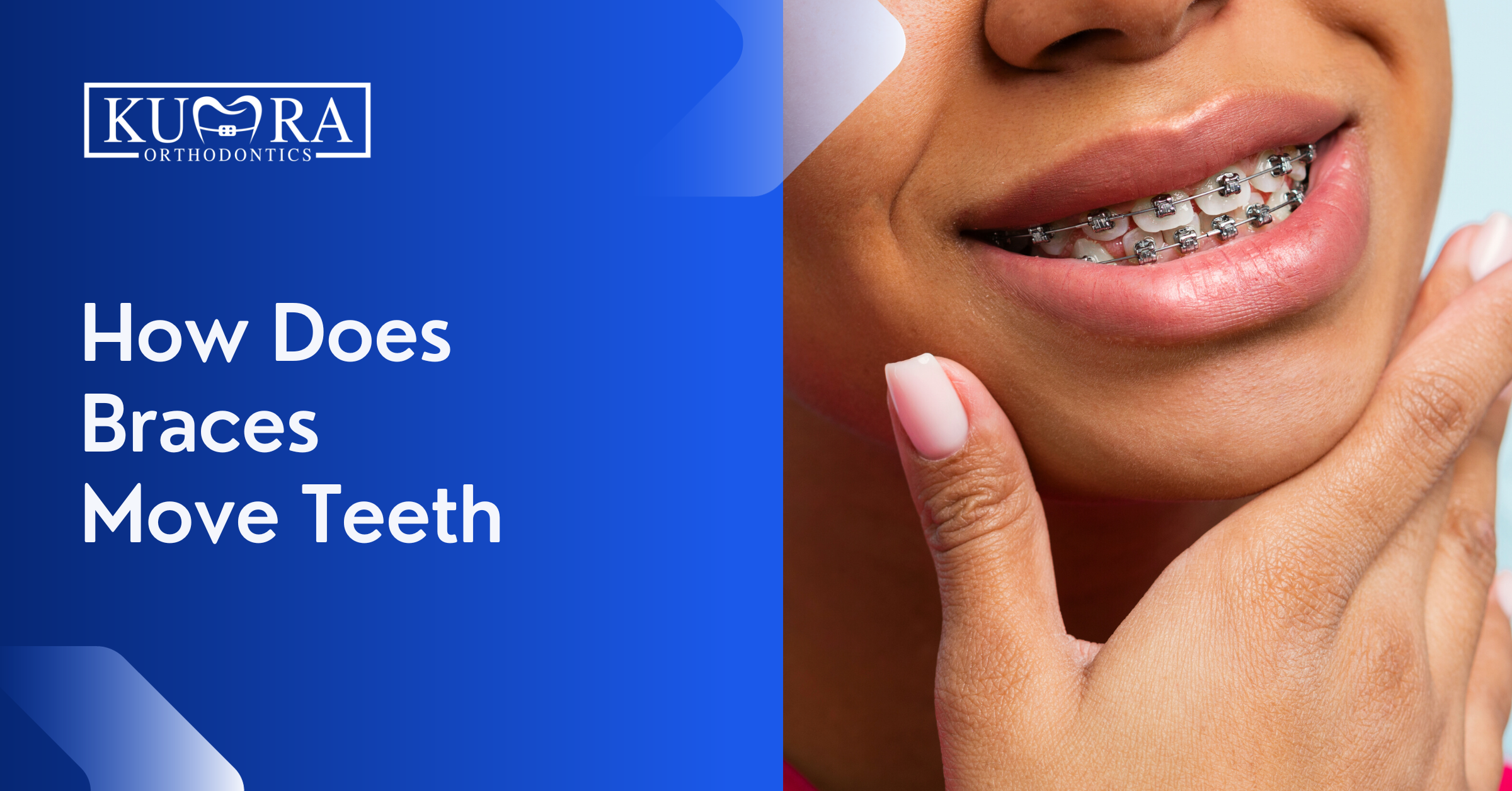Orthodontics, or teeth alignment, is a mix of art and science. The star of the show? Braces! They’ve helped countless people flash confident, healthy smiles. But have you ever stopped to think – how do braces move your teeth? What’s the science behind it all? This article will answer these questions.
Braces are more than just metal pieces. They’re actually a wonder of medical engineering. They use special principles to change your teeth’s position. It’s a careful process that uses gentle pressure, changes in your jawbone, and regular check-ups.
So, let’s glance into how braces work. We’ll walk you through the whole process – from the first appointment to the day the braces come off. We’ll talk about what each part of the brace does, how your body responds, and how all this makes your teeth move.
What Are Braces and What Are They For?
Braces are special tools that dentists use to fix crooked teeth and jaws. They have two main jobs. First, they help make your smile look great by straightening your teeth. Second, they make your mouth healthier. When teeth are not in the right place, it can lead to tooth decay, gum problems, and even trouble with speaking or eating.
There are different types of braces. Traditional metal braces are common and budget-friendly. Ceramic braces are made to match your tooth color, so they’re less noticeable. Lingual braces are hidden behind your teeth. Clear aligners, like Invisalign, are almost invisible and you can take them out when you eat or clean your teeth.
No matter what type they are, all braces work the same way. They put a gentle, steady pressure on your teeth for a long time. This slowly moves your teeth into the right position. Now, let’s look at how this works.
Read More: Should I Get Braces? Things You Should Consider
How Braces Work
The magic of braces treatment comes from each part doing its job efficiently. The brackets (the small squares) are adhered to the front of your teeth. They hold your teeth while they are being moved. The archwire, which is the big wire that connects the brackets, pushes or pulls the teeth.
When braces are first put on, the pressure they create affects the gums under your teeth. This tells your body to break down the bone in front of the moving tooth. As the tooth moves, new bone builds up in the space left behind. This process is called bone remodeling, and it’s how braces treatment achieves lasting results.
The movement is slow and careful, typically spanning a timeline for braces of one to three years. During regular check-ups, the dentist adjusts the tension to make sure the teeth move in the right direction and at the appropriate speed.
It’s a fascinating mix of biology and physics, all happening in your mouth! Understanding how this works can make the idea of getting braces treatment a lot less daunting. So, if you’re considering braces, remember that the process is a scientifically guided, carefully controlled procedure designed to deliver the best possible results for your smile.
Needing an orthodontic appointment?
Visit Kumra Orthodontics Washington, DC or Kumra Orthodontics Stafford, VA, and request an appointment with us!
What Exactly Does a Set of Braces Do For Your Teeth?
Braces do a lot for your teeth. They don’t just make your smile look better, but they also help keep your mouth healthy. Let’s talk about some of the things braces do.
Aligning Misaligned Teeth
One of the primary functions of braces is to rectify misaligned teeth. If your teeth are crowded, have significant gaps, or are simply not straight, braces are the solution. Braces work by exerting a consistent, gentle pressure on your teeth over an extended period.
The pressure gradually shifts your teeth from their current position to the desired alignment, resulting in a straighter smile that boosts your confidence and enhances your appearance.
Rectifying Bite Issues
Braces don’t just improve the aesthetic aspect of your smile; they also play a significant role in correcting functional issues. For instance, they can correct malocclusions, commonly known as bad bites.
These include underbites, overbites, crossbites, and open bites. By aligning the upper and lower jaws for a perfect fit, braces improve bite function. This makes it significantly easier to chew food and articulate words clearly, thus improving your overall quality of life.
Preventing Potential Oral Health Complications
Misaligned teeth can pave the way for a host of oral health problems. These include gum disease, tooth decay, and even tooth loss due to ineffective cleaning.
When teeth are properly aligned, it’s much easier to clean between them effectively, reducing the risk of such issues. Thus, braces indirectly contribute to better oral hygiene and health by making teeth easier to clean.
How Braces Are Placed on Teeth
The process of getting braces involves several meticulous steps undertaken by your orthodontist to ensure the braces fit correctly and function effectively.
Step 1: Thorough Cleaning and Preparation of the Teeth
The first step in getting braces involves a thorough cleaning and drying of your teeth. This step is crucial as it ensures that the surface of the teeth is free from any plaque or particles that could interfere with the subsequent steps, especially the bonding process.
Step 2: Application of Bonding Glue
Once your teeth are clean and dry, the orthodontist will apply a special type of bonding glue to your teeth. This glue is entirely safe and does not harm your teeth in any way.
Its primary function is to adhere to the brackets (the small squares that you see on each tooth) securely.
Step 3: Attachment of Brackets and Archwire
After applying the bonding glue, the orthodontist will carefully place the brackets on each tooth. Once all the brackets are securely in place, the orthodontist will thread the archwire through them. The wire plays a critical role as it applies the gentle pressure required to move your teeth into proper alignment.
The process of getting braces might seem complex, but with a skilled and experienced orthodontist, it’s a safe and efficient procedure. Ultimately, the end result is a healthier, more beautiful smile that can significantly enhance your self-esteem and quality of life.
Related: Why Your Teeth Feel Loose with Braces
Braces Teeth Movement FAQs
How do braces know which way to move teeth?
Braces don’t know which way to move teeth. Instead, your orthodontist devises a treatment plan based on X-rays and molds of your teeth. This plan determines the direction in which each tooth needs to move. The braces, specifically the archwire, apply constant pressure to your teeth, guiding them in the planned direction over time.
When do teeth start moving with braces
Teeth start moving as soon as braces are applied, but it may take several weeks or even a few months for the movement to be noticeable. The exact timing can vary based on the individual’s oral health condition and the specific alignment issues being addressed.
Does a set of braces move your teeth every day?
Yes, braces work by applying continuous pressure on your teeth, causing them to move little by little each day. However, the movement is so gradual that you won’t notice it happening daily.
Can braces pull teeth down?
Yes, braces can pull teeth down or push them up, depending on the correction needed. For example, if a tooth is situated higher than it should be, braces can gradually pull it down to align with the other teeth.
How long does it take for braces to correct teeth alignment?
The length of time it takes for braces to correct teeth alignment varies greatly depending on the individual and the complexity of their case. On average, people wear braces for about 18 months to 2 years. However, minor adjustments might take less time, while more complex cases might require 3 years or more.
Do Braces Really Work?
Yes, braces do work. They are a tried-and-tested method for correcting various dental and orthodontic issues, including misaligned teeth, malocclusions, and overcrowding. The effectiveness of braces is well-documented in numerous scientific studies and dental literature. However, the success of braces depends significantly on the individual’s adherence to their orthodontist’s instructions, such as maintaining good oral hygiene and attending all scheduled adjustment appointments.
Unleash Your Best Smile with Kumra Orthodontics!
Are you tired of hiding your smile because of misaligned teeth or bite issues? Do you dream of having a straight, radiant smile that boosts your confidence and enhances your appearance? We can help transform that dream into reality.
Whether you’re considering braces for yourself or your child, you can trust Kumra Orthodontics to provide top-notch care in a friendly, welcoming environment. Our experienced, expert orthodontists will work closely with you to create a treatment plan that delivers optimal results while fitting comfortably within your lifestyle and budget.
So why wait any longer to start your journey towards a healthier, more beautiful smile? If you have any questions or would like to schedule a consultation, please feel free to contact us. Our expert orthodontist and the rest of our team are ready and eager to assist you.



